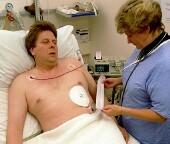Consistent decline in volume of percutaneous coronary intervention and associated costs
THURSDAY, May 7, 2015 (HealthDay News) — Implementation of Appropriate Use Criteria (AUC) is associated with a reduction in percutaneous coronary intervention (PCI) use and with cost savings, according to a study presented at the annual meeting of the American College of Cardiology, held from March 14 to 16 in San Diego.
Puri Pranav, from the University of Chicago, and colleagues quantified the economic impact of the implementation of AUC on PCI volume at a large community hospital. The authors measured the volume of PCI in 12-month intervals for a two-year period following AUC implementation (February 2012) compared with the corresponding two-year period preceding implementation.
The researchers found that the volume of PCI was 1,414 in 2010 and 1,411 in 2011. Following AUC implementation there was a decrease in the number of coronary interventions to 1,174 in 2012 and 970 in 2013; a decrease of 17 percent one year after implementation and a further 17 percent two years after implementation. There were also decreases in the volume of diagnostic cardiac catheterizations, from 2,085 in 2011 to 1,922 in 2012 and 1,652 in 2013. Decreases were also seen in hospital reimbursement for coronary interventions, from $20,784,030 in 2011 to $15,414,620 in 2012 and $13,234,680 in 2013. There were also decreases in reimbursement for diagnostic procedures, from $22,607,655 in 2011 to $19,304,568 in 2012 and $13,234,680 in 2013.
“As physicians are more informed when making decisions, costs come down,” Puri said in a statement.
Copyright © 2015 HealthDay. All rights reserved.








